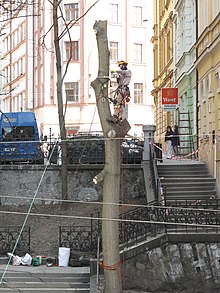Tree care
 From Wikipedia - Reading time: 5 min
From Wikipedia - Reading time: 5 min


(Click for video)
Tree care is the application of arboricultural methods like pruning, trimming, and felling/thinning[1] in built environments. Road verge, greenways, backyard and park woody vegetation are at the center of attention for the tree care industry. Landscape architecture and urban forestry[2][3] also set high demands on professional tree care. High safety standards against the dangers of tree care have helped the industry evolve. Especially felling in space-limited environments poses significant risks: the vicinity of power or telephone lines, insufficient protective gear (against falling dead wood, chainsaw wounds, etc.) and narrow felling zones with endangered nearby buildings, parking cars, etc.. The required equipment and experience usually transcends private means and is often considered too costly as a permanent part of the public infrastructure. In singular cases, traditional tools like handsaws may suffice, but large-scale tree care usually calls for heavy machinery like cranes, bucket trucks, harvesters, and woodchippers.
Road side trees are especially prone to abiotic stress by exhaust fumes, toxic road debris, soil compaction, and drought which makes them susceptible to fungal infections and various plant pests[4] like the spotted lantern fly.[5] When tree removal is not an option, because of road ecology considerations, the main challenge is to achieve road safety (visibility of road signs, blockage-free lanes, etc.) while maintaining tree health.
Tree removal
[edit]
While the perceived risk of death by falling trees (a part of the "tree risk" complex) is influenced by media and often hyped (the objective risk has been reported to be close to 1 : 10.000.000, almost as low as death by lightning),[6] singular events have encouraged a "proactive" stance so that even lightly damaged trees are likely to be removed in urban and public traffic surroundings.[3] As a tree ages and nears the end of its safe useful life expectancy (SULE),[7] its perceived amenity value is decreased greatly. A risk assessment normally carried out by local council's arborist to determine the best course of action.[8][9] As with all public green spaces, trees in green urban spaces and their careful conservation is sometimes in conflict with aggressive urban development even though it is often understood how urban trees contribute to liveability of suburbs and cities both objectively (reduction of urban heat island effect, etc.) and subjectively.[10][11][12][13] Tree planting programs implemented by a growing number of cities, local councils and organizations is mitigating the losses and in most cases increasing the number of trees in suburbia.[14] Programs include the planting of 2 trees for every 1 tree removed, while some councils are paying land owners to keep trees instead of removing them for farming or construction.[15]
Standards
[edit]United States
[edit]The voluntary industry consensus standards developed by TCIA, resulted in the ANSI A300 standard, the generally accepted industry standard for tree care practices including trees, shrubs, and other woody plants.[16] It includes the following parts:
- Pruning
- Soil management
- Supplemental support systems
- Lightning protection systems
- Management
- Planting and transplanting
- Integrated vegetation management
- Root management standard
- Tree risk assessment
- Integrated pest management
Professional associations
[edit]- Tree Care Industry Association
- International Society of Arboriculture
- European Arboricultural Council
See also
[edit]References
[edit]- ^ Council, Cornwall. "Practical Guidelines for Young Tree Care - Cornwall Council". www.cornwall.gov.uk. Retrieved 2018-04-06.
- ^ "Urban Forestry Management in Denver Colorado - Denver Tree Service - Tree Removal - Snow Removal". environmentaltreecarellc.com. Retrieved 2018-06-11.
- ^ a b "Urban Forestry Operations". City of Toronto.
Urban Forestry maintains 4.1 million trees on public property, which includes an estimated 3.5 million trees within Toronto's parks and ravines, and approximately 600,000 trees on City streets. ... The focus of our maintenance service is shifting progressively from reactive maintenance to proactive maintenance.
- ^ Frankfurt, Umweltamt. "Tree protection in Frankfurt : Stadt Frankfurt am Main | Dezernat Umwelt und Gesundheit | Umweltamt". frankfurt-greencity.de (in German). Retrieved 2018-04-06.
- ^ "spotted lantern fly".
- ^ "EPA – Home" (PDF).
- ^ "NOTES ON SAFE USEFUL LIFE EXPECTANCY (SULE RATING) AS USED IN TREE DESCRIPTION" (PDF). strathfield.nsw.gov.au.
- ^ Northrop, Andrew K. Koeser, Gitta Hasing, Drew McLean, and Rob (2016-12-20). "Tree Risk Assessment Methods: A Comparison of Three Common Evaluation Forms". edis.ifas.ufl.edu. Retrieved 2018-04-06.
{{cite web}}: CS1 maint: multiple names: authors list (link) - ^ "Tree Removal Australia – Stay Smart, Save Money". GoTreeQuotes. Retrieved 2018-04-06.
- ^ "Greening Our Streets Street Tree Management Plan" (PDF). City of Whittlesea, Australia. 2016.
- ^ Peter Mitham (2015). "Redevelopment, urban tree removal raise city residents' concerns". Business Vancouver.
- ^ eugenie stockmann (2016). "Are developers to blame for loss of tree cover in urban areas?". The Green Swing.
- ^ Dinh Muoi, Thanh Nien News (2016). "Ho Chi Minh City announces massive tree removal plan for metro station". Archived from the original on April 14, 2016.
Ho Chi Minh City has announced a plan to move and cut down 300 trees on Ton Duc Thang Street in District 1 to make space for a bridge connecting to District 2 and a metro station.
- ^ "Buy Trees and Learn About Trees - Visit our Online Nursery". www.arborday.org. Retrieved 2018-04-06.
- ^ "NVIM Quick Reference Guide. Obligations under the Biodiversity Conservation Strategy" (PDF). environment.vic.gov.au.
- ^ Advanced Solutions International Inc. "TCIA | A300 Standards". www.tcia.org. Retrieved 2018-04-06.
External links
[edit]- "News: Expert workshop on Tree Care and Arboriculture standards in Europe". environmental partnership association.
- "Cover Story: State of the Industry". Lawn & Landscape. 2013.
- Arbor Day Foundation - Tree care
- Our City Forest
 KSF
KSF